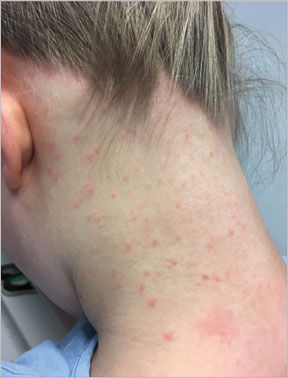A 12-year-old girl with scattered erythematous papules, pustules on her neck


A 12-year-old girl presented with a 3-week history of an itchy rash on the back of her neck. She was previously treated twice with permethrin 1% lotion for lice. She denies having any symptoms on her scalp after treatment. The patient noted that she occasionally played on the floor with her siblings, and recently started wearing some costume jewelry prior to developing the rash. She does not have any other skin involvement. The patient was otherwise healthy and had no other associated symptoms; no one else in her family had a similar rash.
On exam, the patient had multiple scattered erythematous papules and pustules on her posterior neck. She had occipital lymphadenopathy and no evidence of hair breakage or hair loss. No other rashes were noted.

Case Discussion
Pediculosis capitis (A) is a result of the human louse, Pediculus humanus capitis, affecting 1% to 10% of school-aged children. The condition is spread via close contact and by fomites including combs, hats and pillows. The most common symptom is scalp pruritus. However a localized itchy rash on the neck is an alternative presentation. Upon closer examination of our patient, we found several lice and nits (eggs) in her scalp, some of which may be noted in the image provided along her occipital hairline. Adult lice are wingless oblong ectoparasites that measure 1 to 2 mm and lay eggs that are adherent to the hair shaft within 2 mm of the scalp. Lice live for about 30 days on the human host and up to 55 hours off the host.
The diagnosis is clinical, with visualization of lice or nits attached to the hair shaft typically behind the ears and nape of the neck. Nits appear as 0.5- to 1-mm silvery specks that are firmly adherent to the hair shaft, will not easily fall away like regular flakes or dandruff; microscopy is a helpful tool to visualize nits and lice, and a Wood’s lamp can demonstrate fluorescent nits. Occipital and cervical lymphadenopathy may be present, and bluish macules (maculae ceruleae) on the skin of the occipital scalp or nape of neck are other signs of infestation.
Currently, there is a widespread increase in resistance to traditional therapies like permethrin and synergized pyrethrins, and alternative therapies are commonly required for effective treatment. Other traditional therapies include malathion and lindane. Malathion has superior ovicidal activity compared with that of permethrin. However, due to its high alcohol content, it is extremely flammable and irritating. Resistance to malathion has been noted primarily in other countries and not the U.S. The use of lindane should be limited given its significant neurotoxicity risk and the availability of safer options. Newer topical therapies include spinosad solution, ivermectin lotion and benzyl alcohol. Oral ivermectin has also been shown to be effective in resistant cases.
Manual nit removal with a fine comb is a helpful adjuvant to topical therapy. Several treatments are repeated after 7 to 10 days to ensure eradication of lice hatching from eggs that survived the initial application. All close contacts should be treated simultaneously because lice infestations can be asymptomatic. In addition, play areas and furniture should be vacuumed; fomites like bedding, clothing, towels and headwear should be washed in hot water and dried in high heat for at least 40 minutes, whereas nonlaunderable items should be placed in a sealed bag for at least 2 weeks or dry cleaned. Combs and brushes should be soaked in rubbing alcohol for 1 hour after washing thoroughly with hot soapy water or coated with pediculicide for 15 minutes. Hats, brushes, combs, scarves and other grooming aids should not be shared.
The differential diagnosis of head lice presenting as an itchy papular neck rash includes demodicidosis, Pityrosporum folliculitis, allergic contact dermatitis to nickel and tinea capitis.
Demodicidosis is caused by a human ectoparasite that normally inhabit the pilosebaceous unit, Demodex folliculorum and Demodex brevis. This condition primarily affects the face with scaly erythematous papules, pustules and nodules, and causes perioral dermatitis, pustular folliculitis and blepharitis. Mites can be found on skin scrapings with potassium hydroxide or skin biopsy.
Pityrosporum folliculitis, also known as malassezia folliculitis, is due to an overgrowth of yeast within hair follicles and presents as an itchy, acneiform eruption that mainly affects the chest, shoulders and upper back. Contributing factors include sweating, hot and humid environments, and occlusive clothing.
Allergic contact dermatitis is distinguished by brightly erythematous, pruritic coalescing papules and vesicles that correspond to exposure with the causative allergen. Nickel is one of the most common allergens found in jewelry. Allergic contact dermatitis due to nickel in a necklace would likely affect the anterior and posterior neck and may have a more geometric shape corresponding to the shape of the necklace or clasp.
Tinea capitis is most commonly caused by Trichophyton tonsurans and has a variety of presentations, including noninflammatory “black dot” alopecia with hair breakage at the scalp surface and erythematous, scaly patches and plaques with partial alopecia. Pustules and abscesses known as kerions may also be present. Cervical lymphadenopathy is another sign of infection.
Pediculosis capitis (head lice) infestation commonly leads to scalp and nape of neck pruritus, discomfort, social disruption, and loss of school and work days. After closely examining patients to make the diagnosis, providers should know the resistance patterns in their communities to effectively eradicate infestations.
- References:
- Eichenfield LF, et al. Neonatal and Infant Dermatology. 3rd ed. Elsevier; London; 2015.
- Koch E, et al. Pediatr Dermatol. 2016; doi: 10.1111/pde.12982.
- Paller AS, et al. Hurwitz Clinical Pediatric Dermatology: A Textbook of Skin Disorders of Childhood and Adolescence. 5th ed. Elsevier; London; 2016.
- For more information:
- Scarlett Boulos, MD, is a pediatric dermatology fellow at The Children’s Hospital of Philadelphia. She can be reached at bouloss@email.chop.edu.
- Marissa J. Perman, MD, is an attending physician at The Children’s Hospital of Philadelphia.
Disclosures: Boulos and Perman report no relevant financial disclosures.
